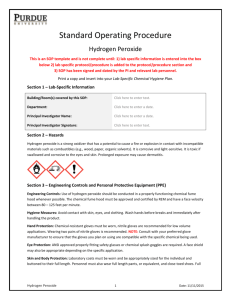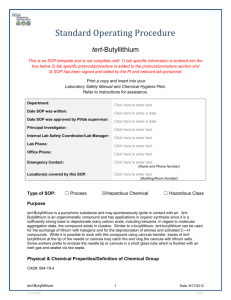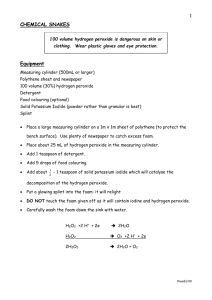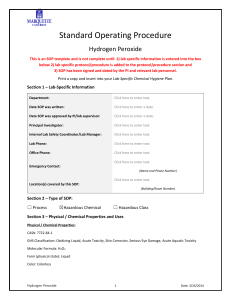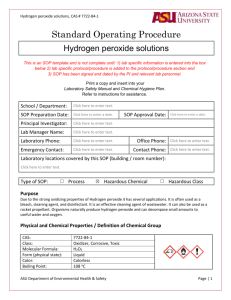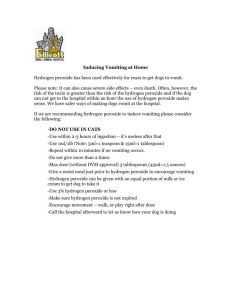Hydrogen peroxide - UCLA David Geffen School of Medicine
advertisement
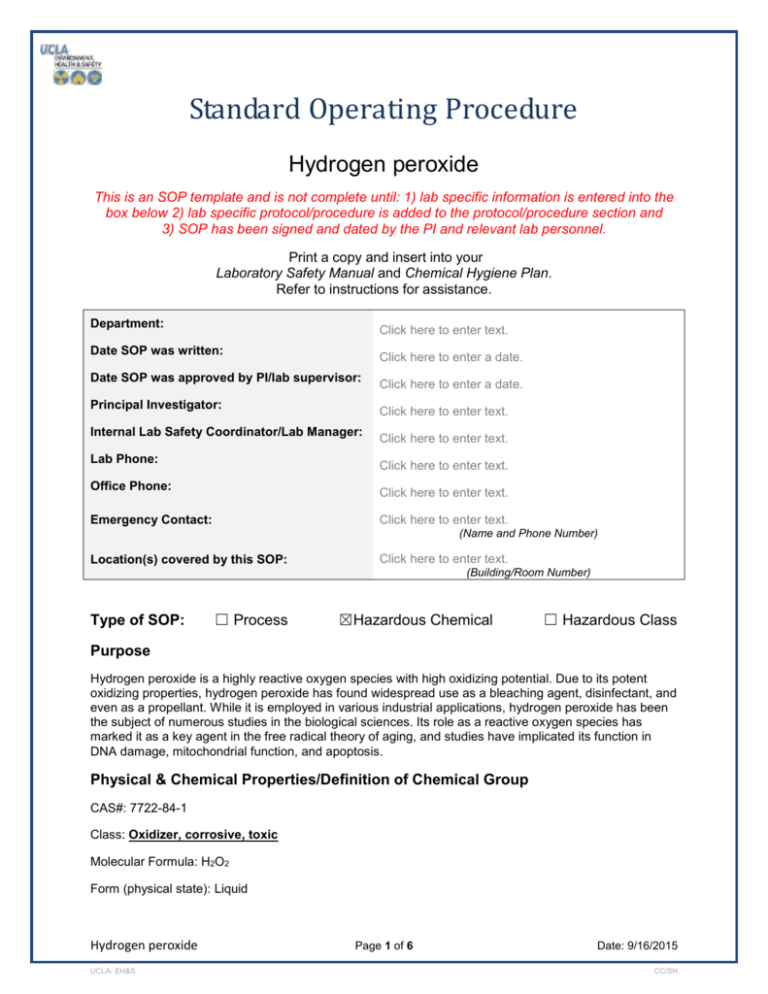
Standard Operating Procedure Hydrogen peroxide This is an SOP template and is not complete until: 1) lab specific information is entered into the box below 2) lab specific protocol/procedure is added to the protocol/procedure section and 3) SOP has been signed and dated by the PI and relevant lab personnel. Print a copy and insert into your Laboratory Safety Manual and Chemical Hygiene Plan. Refer to instructions for assistance. Department: Click here to enter text. Date SOP was written: Click here to enter a date. Date SOP was approved by PI/lab supervisor: Principal Investigator: Click here to enter text. Internal Lab Safety Coordinator/Lab Manager: Lab Phone: Click here to enter a date. Click here to enter text. Click here to enter text. Office Phone: Click here to enter text. Emergency Contact: Click here to enter text. (Name and Phone Number) Location(s) covered by this SOP: Click here to enter text. (Building/Room Number) Type of SOP: ☐ Process ☒Hazardous Chemical ☐ Hazardous Class Purpose Hydrogen peroxide is a highly reactive oxygen species with high oxidizing potential. Due to its potent oxidizing properties, hydrogen peroxide has found widespread use as a bleaching agent, disinfectant, and even as a propellant. While it is employed in various industrial applications, hydrogen peroxide has been the subject of numerous studies in the biological sciences. Its role as a reactive oxygen species has marked it as a key agent in the free radical theory of aging, and studies have implicated its function in DNA damage, mitochondrial function, and apoptosis. Physical & Chemical Properties/Definition of Chemical Group CAS#: 7722-84-1 Class: Oxidizer, corrosive, toxic Molecular Formula: H2O2 Form (physical state): Liquid Hydrogen peroxide UCLA- EH&S Page 1 of 6 Date: 9/16/2015 CC/SH Color: Colorless Boiling point: 108 °C Potential Hazards/Toxicity Hydrogen peroxide is a strong oxidizer that has a potential to cause a fire or explosion in contact with incompatible materials. It is corrosive and light-sensitive. It is toxic if swallowed. It may be harmful if inhaled or absorbed through the skin. May cause burns to digestive and respiratory tract. May cause nausea, vomiting, diarrhea, damage to the red blood cells, stomach distension, bleeding of the stomach, cerebral swelling, and ulcer formation. May cause ulceration of nasal tissue, insomnia, nervous tremors, chemical pneumonia, unconsciousness, and death. It may be destructive to the tissue of the mucous membranes and upper respiratory tract. Cause skin and eye burns. May cause permanent eye damage. May cause central nervous system effects. Prolonged exposure may cause dermatitis. Personal Protective Equipment (PPE) Respirator Protection Use a full-face respirator with multi-purpose combination (US) respirator cartridges as a backup to engineering controls. If the respirator is the sole means of protection, use a full-face supplied air respirator. Respirators should be used only under any of the following circumstances: As a last line of defense (i.e., after engineering and administrative controls have been exhausted). When Permissible Exposure Limit (PEL) has exceeded or when there is a possibility that PEL will be exceeded. Regulations require the use of a respirator. An employer requires the use of a respirator. There is potential for harmful exposure due to an atmospheric contaminant (in the absence of PEL) As PPE in the event of a chemical spill clean-up process Lab personnel intending to use/wear a respirator mask must be trained and fit-tested by EH&S. This is a regulatory requirement. (https://www.ehs.ucla.edu/ep/ih/resp) Hand Protection Handle with gloves. Nitrile gloves are recommended. NOTE: Consult with your preferred glove manufacturer to ensure that the gloves you plan on using are compatible with hydrogen peroxide. Refer to glove selection chart from the links below: http://www.ansellpro.com/download/Ansell_8thEditionChemicalResistanceGuide.pdf OR http://www.allsafetyproducts.com/glove-selection-chart-chemical-breakthrough-ratings.html OR http://www.showabestglove.com/site/default.aspx OR http://www.mapaglove.com/ Eye Protection ANSI approved, tight-fitting safety glasses/goggles. Face shields are also recommended. Skin and Body Protection Hydrogen peroxide UCLA- EH&S Page 2 of 6 Date: 9/16/2015 CC/SH Lab coats should be worn. These laboratory coats must be appropriately sized for the individual and be buttoned to their full length. Laboratory coat sleeves must be of a sufficient length to prevent skin exposure while wearing gloves. Full length pants and close-toed shoes must be worn at all times by all individuals that are occupying the laboratory area. The area of skin between the shoe and ankle should not be exposed. Hygiene Measures Avoid contact with skin, eyes and clothing. Wash hands before breaks and immediately after handling the product. Engineering Controls Chemical fume hood. Good ventilation. First Aid Procedures If inhaled Move person into fresh air. If not breathing, give artificial respiration. If breathing is difficult, give oxygen. Consult a physician. In case of skin contact Wash off with soap and plenty of water for at least 15 minutes while removing contaminated clothing. Consult a physician. In case of eye contact Rinse thoroughly with plenty of water for at least 15 minutes lifting upper and lower eyelids and removing contact lenses. Consult a physician. Continue rinsing eyes during transport to hospital. If swallowed Do not induce vomiting. Never give anything by mouth to an unconscious person. If victim is conscious and alert, give 2-4 cupfuls of milk or water. Rinse mouth with water. Consult a physician. Special Handling and Storage Requirements Precautions for safe handling: Avoid contact with skin, eyes, and clothing. Avoid inhalation and ingestion. Ensure adequate ventilation. Keep away from sources of ignition- No smoking. Conditions for safe storage: Keep container tightly closed in a dry and well-ventilated area. Opened containers must be carefully resealed and kept upright to prevent leakage. Recommended storage temperature is 2-8 °C. Store protected from light. Store away from combustible materials. Avoid alkalies, oxidizable material, alcohols, permanganates, zinc, powdered metals, iron, copper, nickel, brass, iron and iron salts. Spill and Accident Procedure Chemical Spill Dial 911 and x59797 Spill – Assess the extent of danger. Help contaminated or injured persons. Evacuate the spill area. Avoid breathing vapors. If possible, confine the spill to a small area using a spill kit or absorbent material. Keep others from entering contaminated area (e.g., use caution tape, barriers, etc.). Small (<1 L) – If you have training, you may assist in the clean-up effort. Use appropriate personal protective equipment and clean-up material for chemical spilled. Double bag spill waste in clear plastic bags, label and take to the next chemical waste pick-up. Large (>1 L) – Dial 911 (or 310-825-1491 from cell phone) and EH&S at x59797 for assistance. Hydrogen peroxide UCLA- EH&S Page 3 of 6 Date: 9/16/2015 CC/SH Chemical Spill on Body or Clothes – Remove clothing and rinse body thoroughly in emergency shower for at least 15 minutes. Seek medical attention. Notify supervisor and EH&S at x59797 immediately. Chemical Splash Into Eyes – Immediately rinse eyeball and inner surface of eyelid with water from the emergency eyewash station for 15 minutes by forcibly holding the eye open. Seek medical attention. Notify supervisor and EH&S at x59797 immediately. Medical Emergency Dial 911 or x52111 Life Threatening Emergency, After Hours, Weekends And Holidays – Dial 911 (or 310-825-1491 from cell phone) or contact the Ronald Reagan UCLA Medical Center (emergency room) directly at x52111 (located at 757 Westwood Plaza, enter from Gayley Avenue). Note: All serious injuries must be reported to EH&S at x59797 within 8 hours. Non-Life Threatening Emergency – Go to the Occupational Health Facility (OHF), x56771, CHS room 67-120 (This is on the 6th floor, 7th corridor, room 120. Enter through the School of Dentistry on Tiverton Drive and proceed to the “O” elevator to the 6th floor.)Hours: M - F, 7:30 a.m. to 4:30 p.m. At all other times report to Ronald Reagan UCLA Medical Center (emergency room) at x52111. Note: All serious injuries must be reported to EH&S at x59797 within 8 hours. Needle stick/puncture exposure (as applicable to chemical handling procedure) – Wash the affected area with antiseptic soap and warm water for 15 minutes. For mucous membrane exposure, flush the affected area for 15 minutes using an eyewash station. Page the needle stick nurse by dialing 231 from a campus phone, enter 93333 when prompted and then enter your extension. Hours: M – F, 8:00 a.m. to 4:00 p.m. At all other times report to Ronald Reagan UCLA Medical Center (emergency room) at x52111. Note: All needle stick/puncture exposures must be reported to EH&S at x59797 within 8 hours. Decontamination/Waste Disposal Procedure Wearing proper PPE, decontaminate equipment and bench tops using soap and water. Rinse used containers thoroughly with water before disposal. General hazardous waste disposal guidelines: Label Waste Affix an on-line hazardous waste tag on all waste containers using the WASTe Online Tag Program https://ehs.ucop.edu/waste as soon as the first drop of waste is added to the container Store Waste Store hazardous waste in closed containers, in secondary containment and in a designated location Double-bag dry waste using transparent bags https://www.ehs.ucla.edu/hazwaste/management/containers Waste must be under the control of the person generating & disposing of it Dispose of Waste Dispose of regularly generated chemical waste within 90 days Call EH&S at x61887 for questions Empty Containers o Dispose as hazardous waste if it once held extremely hazardous waste (irrespective of the container size) https://www.ehs.ucla.edu/hazwaste/types/extremely-hazardous o Consult waste pick-up schedule o https://www.ehs.ucla.edu/hazwaste/management/pick-ups Prepare for transport to pick-up location Check on-line waste tag Write date of pick-up on the waste tag Use secondary containment Hydrogen peroxide UCLA- EH&S Page 4 of 6 Date: 9/16/2015 CC/SH Safety Data Sheet (SDS) Location Online SDS can be accessed at http://msds.ehs.ucla.edu. Protocol/Procedure Quantities covered by this SOP: 0 – 1mL from a 500 g bottle Conditions covered by this SOP: 0 °C – 50 °C Hydrogen peroxide is an eye, skin and respiratory irritant. Handle with standard PPE. Hydrogen peroxide can be used to catalyze DNA damage for the purposes of studying DNA damage response or apoptotic pathways. 1. Hydrogen peroxide (50% w/v) is diluted in DMEM into 1M stock concentration immediately prior to cell treatment. 2. This stock is then used to prepare final concentrations ranging from 0-100mM in cell culture media. 3. Cells may be treated for short time points (15min) or longer (24h) depending on the type of response (DNA damage response, p53 upregulation, apoptosis) to be evaluated. 4. Cells may be fixed for staining with DNA damage markers, or harvested for real time PCR or protein extraction and Western Blot analysis. NOTE Any deviation from this SOP requires approval from PI. Documentation of Training (signature of all users is required) Prior to conducting any work with hydrogen peroxide, designated personnel must provide training to his/her laboratory personnel specific to the hazards involved in working with this substance, work area decontamination, and emergency procedures. The Principal Investigator must provide his/her laboratory personnel with a copy of this SOP and a copy of the SDS provided by the manufacturer. The Principal Investigator must ensure that his/her laboratory personnel have attended appropriate laboratory safety training or refresher training within the last one year. Principal Investigator SOP Approval Print name __________________________Signature___________________________ Approval Date: I have read and understand the content of this SOP: Name Hydrogen peroxide UCLA- EH&S Signature Page 5 of 6 Date Date: 9/16/2015 CC/SH Click here to enter text. Click here to enter a date. Click here to enter text. Click here to enter a date. Click here to enter text. Click here to enter a date. Click here to enter text. Click here to enter a date. Click here to enter text. Click here to enter a date. Click here to enter text. Click here to enter a date. Click here to enter text. Click here to enter a date. Click here to enter a date. Click here to enter text. Click here to enter text. Click here to enter a date. Click here to enter text. Click here to enter a date. Click here to enter text. Click here to enter a date. Click here to enter text. Click here to enter a date. Click here to enter text. Click here to enter a date. Click here to enter a date. Click here to enter text. Click here to enter text. Hydrogen peroxide UCLA- EH&S Click here to enter a date. Page 6 of 6 Date: 9/16/2015 CC/SH


